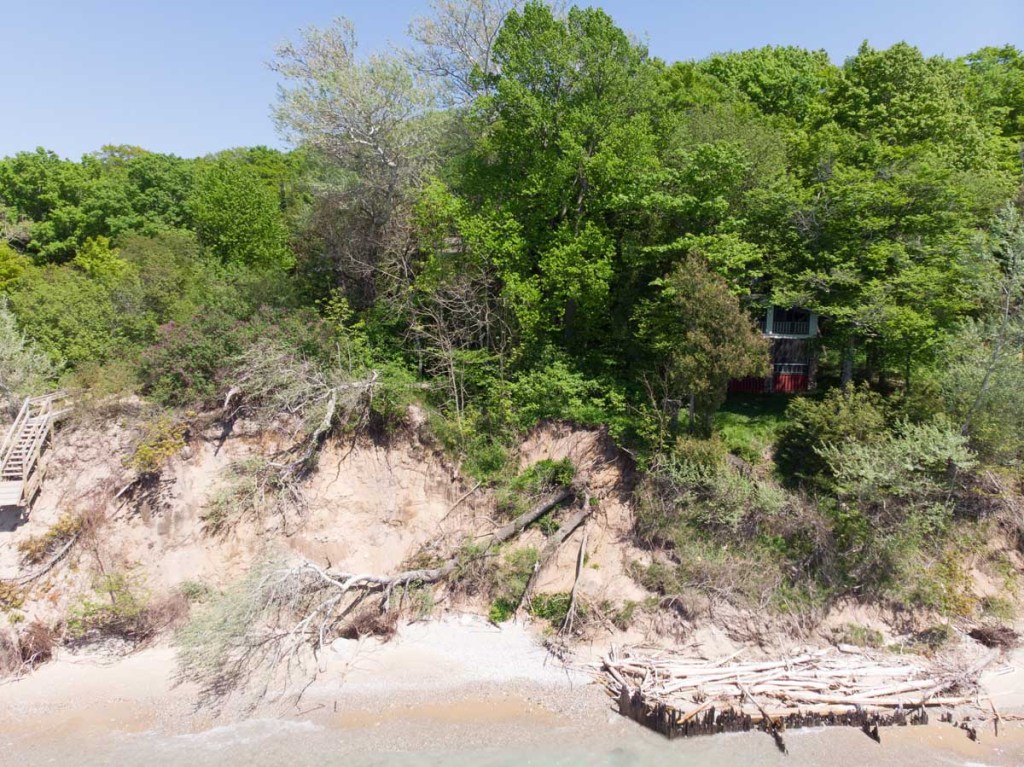Calling Lake Michigan’s bluff: Michigan cottage owners fight high water, erosion
Published 8:00 am Wednesday, June 10, 2020

- This picture, taken from drone footage, shows the damage caused by high water along about a mile of Lake Michigan shoreline in Benzie County.
FRANKFORT, Michigan — Dennis Nahnsen’s cottage has been in his family since 1946.
When he was younger he and his wife and children moved around a lot, but the modest Frankfort, Michigan, cottage was the place they returned to every summer.
The cottage, located on an eroding Lake Michigan bluff in Benzie County, is now threatening to tumble down the sand and into the lake.
A project to install a seawall along the toe of the bluff aims to change that path.
“We are in danger of losing our bluff,” said Dennis Nahnsen. “If we did nothing this year the homes would fall into the lake within a year or two or three.”
Dennis Nahnsen is president of the Wildewood Association, a group of 25 cottages located on Lake Michigan about two miles north of Frankfort. Eleven of those cottages are perched atop Sunset Slope, which is owned by the association.
The group hired a consultant about a year ago when it became apparent that if nothing was done the 11 cottages would eventually be lost, said Nahnsen, of St. Louis.
Permits for the seawall have been obtained from the Michigan Department of Environment, Great Lakes, and Energy and from the U.S Army Corps of Engineers. Steel sheets about 15 feet tall will be buried about 10 feet into the sand, with about 5 feet left visible.
In 1986, when water levels were at a 100-year high, a similar wooden wall was placed along the shoreline. It soon was covered up with sand because the water receded and only an inch or so can now be seen, but it did stave off erosion of the bluff for many years, Nahnsen said.
This year, those high-water records are being broken.
“At the low point we had 150 feet of shore,” Nahnsen said. “Now we have none.”
Homeowners along the tall northern Michigan bluff aren’t alone. Property owners and municipalities dotting the Lake Michigan and Lake Huron shorelines have spent the past year bracing as water levels continue to rise, damaging both infrastructure and homes. Earlier this year, a section of northern Michigan road on the idyllic Old Mission Peninsula fell into the lake.
The high water has similarly negatively impacted sewer, water and electrical infrastructure in several Great Lakes coastal towns.
The scene homeowners in Benzie County face has become commonplace as the lake chews away at the toe of tall, sand bluffs that comprise much of Lake Michigan’s shoreline.
The bluff below Nahnsen’s cottage is all sand and when wave action scours its base the top of the bluff eventually collapses. Over the last several years, since water levels have been on the rise, the toe of the bluff has moved back about 40 feet, while the top has lost about 20 feet. Nahnsen’s cottage is now about 25 feet from the edge of the bluff.
But there is wide disagreement about the efficacy of constructing seawalls to protect the ground beneath lakefront homes.
Experts in hydrology, engineering, shoreline protection contend the environment is in control.
Installing seawalls or adding boulders along the shore can cause wave energy to scour the lake bottom instead, washing sand out into deep water where it cannot be returned to the shoreline when water levels recede. It can also cause further erosion to neighboring properties.
Moving a home back is the best option for those in danger of losing them, they say. For many, demolishing a home is the solution, as seawalls may not be permitted or the cost is too high.
Nahnsen said moving the homes back is not an option for the 11 cottages on Sunset Slope, as the lots are too small.
Each lot owner in the Wildewood Association will pay $30,000 to $50,000 for the seawall, depending on how many feet they have, Nahnsen said.





